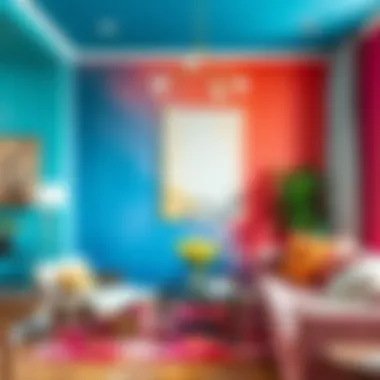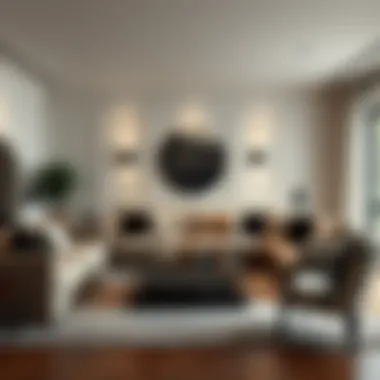Designing a Living Room Without Boundaries: A Comprehensive Guide


Intro
The living room often serves as the heart of a home, a canvas where memories are painted and daily life unfolds. It's the meeting place for families, friends, and visitors—where laughter echoes and stories are shared. Designing a living room that embraces a sense of openness while also being practical and beautiful is not just a theoretical challenge but an opportunity to redefine how we experience our spaces.
In this guide, we will explore the intricacies of creating a living room that feels airy and boundaryless, yet still manages to be functional for everyday needs. We won't just scratch the surface; rather, we will delve into effective strategies, from furniture selection to color schemes, ensuring that everyone can find inspiration, regardless of their style preference or budget constraints.
Whether you are a DIY enthusiast excited to put your personal touch on a room, a homeowner looking to refresh a tired space, or a designer aiming to stay ahead of the curve, there’s something here for you. With the right approach, you can transform your living room into a stylish retreat that feels uniquely yours. Let's embark on this journey to unleash your living space's full potential!
Prologue to Living Room Design
The living room is often dubbed the "heart of the home," and rightly so. This space serves as a hub for family gatherings, social interactions, and the occasional solitary retreat with a good book. So, why is a well-designed living room so important? First off, it sets the tone of your dwelling—it reflects who you are and how you wish to engage with the world around you.
Designing this space without boundaries means embracing a fluid design approach, where functionality meets aesthetics seamlessly. You're not just throwing some furniture into a room and calling it a day. No, it's about crafting an environment that feels open, welcoming, and flexible, all while maintaining a sense of flow that guides people through the space.
Several factors contribute to a successful living room design. From selecting the right color palette to arrangement strategies that encourage movement, each element plays a pivotal role. Attention to detail isn’t just beneficial; it’s essential. Every layout decision influences the interactions that take place within the space and affects how comfortable and relaxed you, your family, and guests will feel.
In this guide, we will delve into the essentials of living room design, uncovering tips for assessing personal style and understanding how best to reflect that in your space. The journey from a mediocre living room to a well-thought-out sanctuary is what we aim to explore. So, let’s roll up our sleeves and get to the grind!
The Importance of a Well-Designed Living Room
A well-designed living room does more than just look pretty. It plays a vital role in facilitating everyday life. Think of it as the backdrop to countless memories. Family movie nights, birthday celebrations, or simply cozy afternoons spent lounging around are all enhanced by a thoughtfully arranged space. Beyond its practical uses, a well-crafted living room acts as an emotional anchor, a sanctuary from the noise of the world.
Here are some benefits that can't be overlooked:
- Comfort: A well-planned layout encourages relaxation. Choosing the right furniture and arranging it smartly can change mood and functionality.
- Social Interaction: A fluid space encourages connections, allowing conversations to flow naturally without physical barriers.
- Aesthetic Appeal: It reflects your style and personality. A visually appealing space can boost your spirits and help you feel more at home.
- Resale Value: As it turns out, a beautifully designed living room can enhance your property's worth when it comes time to sell.
In all, investing in smart living room design is essentially about being more intentional with how you create memories and experiences.
Understanding Personal Style and Functionality
Now, let’s embark on a journey of self-discovery within your living space. Understanding your personal style is like finding the perfect pair of shoes; comfort alongside style is vital. The trick lies in discerning what resonates with you while equipping the space with proper functionality.
When considering your individual taste, you might ask yourself:
- Do you lean toward minimalism or maximalism?
- Are earthy tones more your vibe or do bright colors ignite joy?
- What styles do I resonate with—bohemian, industrial, mid-century modern?
By understanding personal style, you can curate your living room to genuinely reflect you.
At the same time, functionality should never take a backseat. Ask yourself:
- What activities do you envision in this space?
- Do you require ample seating for family gatherings, or is it more of a quiet corner for relaxation?
Finding a harmonious blend of both elements—style and function—will ensure your living room will not only look stunning but serve as a space that meets your everyday needs, allowing for a seamless balance between life and relaxation.
Essentials of Space Planning
When it comes to crafting a living room that feels open and cohesive, space planning is the backbone of the design process. It involves analyzing the layout of your space, understanding how you and others move through it, and planning various zones for different activities. A well-thought-out plan doesn't just look good on paper; it shapes the day-to-day usability of your home.
Assessing Your Living Space
Before diving into your design, give your living space a thorough once-over. Take into account its dimensions, natural light sources, and existing architectural features like windows, doors, or built-in shelving. Measuring your space lets you identify areas that may feel cramped or awkward, helping you make an informed decision about furniture placement.
It’s also vital to consider the flow of the room. Stand in the middle of your living space and visualize how you navigate through it daily. For instance, are there furniture pieces that obstruct movement? Are there paths that feel too narrow? Ensure that you’re able to walk from one zone to another without feeling like you're maneuvering through a maze.
Tip: Keep a measuring tape and a notepad handy as you assess your area. It’s sharper than relying solely on memory and provides a solid reference point throughout your planning process.
Creating Zones for Different Activities
Your living room doesn't have to be a one-trick pony. By carving out specific zones, you can designed a space that accommodates various activities. Think along the lines of cozy corners for reading, family areas for movie nights, or even a workspace if your needs allow it. A simple way to define these spaces is through the use of rugs or furniture arrangement.
Here are some ways to seamlessly integrate zones into your living space:
- Rugs: Use distinct area rugs to delineate different zones. A plush rug beneath a coffee table can create a casual living area, while a smaller one might set the stage for an inviting reading nook.
- Furniture arrangement: Position furniture to encourage conversations. Chairs facing each other foster dialogue, while a couch facing a media center creates a relaxing viewing area.
- Use of dividers: If you prefer some separation, consider low shelves or indoor plants that act as natural dividers without overwhelming the room.
This not only optimizes the function of your living room but also enhances the overall aesthetic appeal.
Flow and Movement: Navigating Your Design
So, what’s the deal with flow? Think of it as the lifeblood of your living room—good flow allows for smooth transitions between activities. You want your space to feel inviting, not like an area that requires a detailed map to navigate.


One of the quickest ways to assess the flow is to do a little test run. Imagine hosting a get-together: how easily can guests move from the snack table to the seating area? Is there a clear path that doesn’t require ducking under furniture? Here are some pointers to ensure a good flow:
- Maintain clear pathways: Ideally, pathways should be at least two to three feet wide to ensure comfortable movement.
- Group similar functions: Keep seating areas, entertainment centers, and activities close together. A TV that’s miles away from seating can feel disjointed.
- Avoid blocking traffic: Steer clear of placing large furniture pieces in the middle of flow areas. This makes it easy for anyone to walk without having to shuffle around barriers.
Creating a space that feels open and functional goes beyond aesthetics; it directly contributes to a lively and pleasant living experience. This foundational approach ensures that your living room won't just look good but will feel good as well, fostering a warm environment for social interaction, relaxation, and daily life.
"A thoughtfully planned living space is not just about looks; it's about lifestyle"
By focusing on space planning, you can create a harmonious living room that transitions seamlessly between various usages while reflecting your personal tastes.
Selecting the Right Furniture
Choosing the right furniture plays a critical role in designing a living room without boundaries. It shapes the character of the space and directly influences both functionality and aesthetics. Furniture isn't just about filling the space; it's about creating a cohesive atmosphere that resonates with personal style while serving diverse purposes. In a living room, every piece should contribute to an inviting environment that feels open and welcoming, especially if you want to eliminate physical divisions in your design.
Determining Key Furniture Pieces
To establish a fluid and seamless living area, identifying key furniture pieces is essential. Start with the foundation—this usually means a well-chosen sofa or sectional that acts as a focal point. It’s the anchor that grounds the space. When selecting a sofa, think on both form and function. Consider the size and shape of your room. A sectional can offer ample seating while maintaining an open feel, while a more compact sofa can help enhance flexibility.
- Versatility is crucial. Look for pieces that can adapt to various activities, from lounging to entertaining.
- Storage options within furniture pieces are also valuable. For instance, consider ottomans that double as coffee tables or benches that offer hidden storage, allowing for easy organization without sacrificing style.
Moreover, the coffee table, armchairs, and side tables should be carefully selected to complement each other while remaining functional. This is particularly important in spaces with fewer boundaries, as each piece should flow well with its neighbors and create a visually appealing arrangement.
Balancing Style and Comfort
In designing a living room, finding the right balance between style and comfort cannot be understated. It's tempting to focus solely on aesthetics, but a pretty space can feel empty if it's not comfortable. Think about how you distribute these elements—will you prioritize sleek, modern lines or opt for plush, inviting forms?
- Sofas and chairs should have enough cushioning to invite guests to sit for a while. Look for textiles like cotton or velvet that feel cozy but also stand the test of time.
- When choosing colors and patterns, keep in mind that neutral tones can often serve as a backdrop allowing colorful accents and decorative pillows to add personality. However, for those with a love for bold choices, a bright sofa can indeed act like a piece of art within the living room.
In essence, furniture should reflect the lifestyle of those who inhabit the space. If inviting friends over for game nights is a routine, opt for durable materials that can withstand daily wear and tear, while still fulfilling the desire for style.
Innovative Furniture Solutions for Small Spaces
Living in a small space doesn't mean compromising on style or function. In fact, it encourages creativity in selecting furniture. Innovative solutions abound that maximize utility without cramping your style.
- Think about modular furniture. Sofas that can be rearranged for different purposes foster both versatility and a sense of openness.
- Wall-mounted shelves can replace bulky bookcases, providing ample display space for books and decor while maintaining a light visual footprint.
- Folding tables are another great option. They can be expanded when entertaining but collapsed afterwards, making them perfect for multifunctional spaces.
When working with limited square footage, also keep an eye out for transparent furniture. Acrylic or glass items can create a sense of spaciousness, as they allow light to pass through. This might seem minor, but it subtly enhances the feeling of openness in a compact space.
"Space savers reveal the potential of small rooms, turning them from cramped to cozy with clever solutions."
Color and Texture Considerations
When it comes to designing a living room that breathes life into your everyday experiences, color and texture are essential players. They help to set the tone of the space, communicate personality, and create an overall atmosphere. Not only do these elements beautify a room, but they also serve functional purposes. Understanding how to harness color and texture can lead to a living room that encourages relaxation, inspires creativity, and entertains guests seamlessly.
The Psychology of Color in Living Spaces
Colors have an undeniable impact on our emotions, and that’s why understanding the psychology of color is crucial. Each color can evoke specific feelings, influencing how we feel in our living space. For instance, soft blues can produce a sense of calm, while yellows often inspire cheerfulness and energy. It’s not just about choosing a color; it’s about ensuring that the hues resonate with your desired ambiance.
- Warm colors like reds, oranges, and yellows create a cocoon of warmth, making the space feel inviting and cozy,
- Cool colors such as blues and greens promote relaxation, ideal for when you want to unwind after a long day.
- Neutral tones can act as a backdrop, allowing accent colors and textures to shine.
A mix of colors can also create a dynamic visual interest. Utilizing colors that complement one another enhances cohesiveness; however, a common pitfall is overcrowding a space with too many loud colors. Using a color wheel can guide your choices effectively when deciding on a color palette.
"Color isn't just a form of decoration; it’s a form of communication. It says how we feel, how we want others to feel, and sometimes it even speaks for us."
Incorporating Texture for Depth
Texture plays an instrumental role in adding layers and depth to your living room design. It goes beyond simple aesthetics; the tactile variety of materials can greatly influence how a space is experienced. Consider mixing various textures to keep the eye engaged and the environment inviting. Here are key ways to weave texture into your living space:
- Fabrics: Soft velvet cushions or chunky knit throws can provide comfort while adding visual warmth. A combination of smooth and rough fabrics can lead to an interesting contrast.
- Wood and Metal: Wooden furniture can ground a space, while metal accents like light fixtures or decorative items can add a modern edge.
- Rugs: Area rugs can demarcate zones, softening hard floors and adding an element of coziness. Different patterns in rugs can also act as conversation starters.
- Wall Treatments: Textured walls—from brick to wood paneling—offer a third dimension, changing how light interacts with surfaces.
Incorporating varied textures ensures your living space feels alive. It’s about creating an experience that invites touch and interaction, compelling those within it to engage with their surroundings.
As you design your living room, keep in mind the balancing act of colors and textures. Making informed choices in these areas not only enhances the aesthetic but also enriches the functional use of the space, ultimately supporting a lifestyle that's seamless and enjoyable.
Incorporating Lighting
Lighting is arguably one of the most crucial elements when it comes to designing any space, especially a living room. The right lighting can transform a bland environment into a warm, inviting haven. It's not just about illumination—it's about mood, functionality, and defining the character of the room. Throughout this section, we will explore the nuances of using natural and artificial light, as well as the importance of layering different light sources to create an effective and dynamic space.
Natural vs. Artificial Lighting
Natural light is the gold standard in lighting design. Nothing quite compares to sunlight filtering through windows, casting gentle shadows and bringing warmth to a room. Many homeowners yearn for large windows or glass doors to enhance their living spaces. However, it's not just about having large openings; placement matters, too. A south-facing window will capture light throughout the day, whereas a north-facing one may only allow for softer, indirect lighting.


Consider these key factors when maximizing natural light:
- Window Treatments: Sheer curtains can diffuse harsh sunlight while still letting it in. Blinds can be adjusted to control the intensity of light during different times of the day.
- Reflective Surfaces: Adding mirrors or glossy finishes can bounce light around, making a room feel larger and brighter.
- Room Orientation: Before committing to a design, evaluate how the sun moves through your space throughout the day and adjust your layout according to where you receive the most natural light.
On the flip side, artificial lighting plays an indispensable role. It’s essential for evening gatherings, cooler months, or even for spaces that lack adequate natural light. From ambient lighting, which creates an overall glow, to accent and task lighting that zones specific areas, each type has its unique function.
"The right light can make or break a space, much like the right paint or furniture arrangements."
Layering Light Sources for Effect
Layering light sources means utilizing various types of lighting to create an adaptable and versatile environment. By mixing ambient, task, and accent lighting, you can enhance the functionality of your living room while also establishing different moods.
Consider the following layers:
- Ambient Lighting: This is your primary light source, usually from ceiling fixtures or recessed lights. It provides uniform illumination and should be the backbone of your lighting design.
- Task Lighting: Table lamps, floor lamps, and even pendants over reading areas ensure adequate lighting for specific activities, like reading a book or working on a project.
- Accent Lighting: Use spotlights, sconces, or even LED strips to highlight artwork, architectural features, or plants, creating visual interest and depth in your living room.
Placing these lighting elements strategically allows for flexibility. For example, during a cozy movie night, you could dim the ambient lights, turn on task lighting beside the sofa for snacks, and accentuate art on the walls with soft spotlights. This setup both enhances comfort and streamlines the activities you and your guests will partake in.
Lighting isn't merely functional; when done right, it enhances the aesthetic appeal of your space. Aim for a balance that feels curated—this attention to detail could be the very difference that draws admiration from guests.
By understanding and employing both natural and artificial light effectively, you are well on your way to creating a living room that speaks of warmth, comfort, and style.
Accessorizing Your Living Room
Accessorizing your living room is where the magic happens. It's the fine details that can turn a standard room into a cherished haven. It's not just about decoration, but about infusing your personal touch into a space where you entertain guests or unwind after a long day. The right accessories can enhance the overall design, making it cohesive and visually appealing.
When choosing extras for your living room, consider not just aesthetics, but also function. Here are a few elements to keep in mind:
- Art Pieces: These are more than just wall ornaments. A well-placed painting or sculpture can become a conversation starter, setting the tone of the room.
- Decorative Items: Think about using vases, candles, and decorative trays. They can add layers and dimension to flat surfaces like coffee tables and shelves.
- Textiles: Pillows and throws are like the cherry on top of your design sundae. They can soften hard surfaces and add a splash of color or pattern.
The beauty of accessorizing is the freedom it offers. You can mix and match styles, colors, and textures to reflect your personality. Take a moment to think about what resonates with you and what kind of atmosphere you wish to cultivate in your living space. A little thoughtfulness goes a long way.
"Accessories are the exclamation point of a woman's outfit." – Mark Twain
This quote, while metaphorical for fashion, rings true in home design as well. The right accessories can punctuate your living room’s decor beautifully.
The Role of Art and Decorative Items
Art and decorative items serve a crucial role in the living room. They can create a focal point or enhance the ambiance of the space. Selecting art that speaks to you is vital. It should resonate emotionally, whether that’s through color, theme, or style. Consider these points:
- Personal Connection: Invest in pieces that tell your story or reflect your travels. It adds character and warmth.
- Size Matters: Oversized art can make a bold statement, while smaller pieces can create an intimate feel.
- Placement: A piece of art hung at eye level allows for easier appreciation. Grouping smaller pieces can create a gallery effect, making the wall more engaging.
Choosing Plants to Enhance Your Space
Incorporating plants enhances not only the visual appeal but also the atmosphere of your living room. They breathe life into your space, literally and figuratively. Plants help purify the air and can also enhance your mood.
When selecting plants, consider those that thrive indoors with minimal care, such as:
- Snake Plant: Resilient and tolerant of neglect, it also has air-purifying qualities.
- Pothos: Its trailing vines add lushness, and it’s easy to propagate.
- Peace Lily: Known for its elegant blooms and low light tolerance.
Think about placing larger plants in corners to fill empty spaces, while smaller plants can brighten up shelves or coffee tables. Choosing decorative pots that complement your decor can tie the whole room together. Remember, each plant isn't merely an object; it’s a connection to nature, wrapping your living room in lush vitality.
Sustainable And Ethical Design Choices
In the realm of interior design, the conversation around sustainability has shifted from niche to necessity. Homeowners are increasingly aware of the environmental impact their choices carry. When it comes to designing a living room, opting for sustainable and ethical design choices can make a world of difference, not only for the planet but for the mood and vibe of your home as well.
Choosing sustainable materials means prioritizing those that minimize harm to the environment. This can include reclaimed wood, bamboo, recycled metals, or organic textiles. Such materials are not just trendy; they often offer unique textures and character that mass-produced options lack. The beauty lies in their individuality and reduced carbon footprint. It’s about being more thoughtful in our consumption patterns, asking ourselves how we can generate less waste while creating our cozy retreats.
A well-designed living room that incorporates these principles is not just a stylish haven; it becomes a statement of values, reflecting the homeowner's commitment to the environment. The personal satisfaction derived from creating a space that aligns with our beliefs can enhance the overall living experience, making our homes feel more authentic and meaningful.
The Importance of Sustainable Materials
When we think about sustainable materials, it’s essential to recognize their long-term benefits. For instance, opting for sustainably sourced wood not only helps reduce deforestation but also supports responsible forestry practices.
Here are some key points regarding sustainable materials:
- Healthier Indoor Air Quality: Many traditional materials emit volatile organic compounds (VOCs) which can degrade air quality. Sustainable materials often lack these harmful substances, leading to a healthier home.
- Durability: Environmentally friendly materials tend to be more robust. This longevity means fewer replacements over time, aligning with both ecological desires and economic sensibility.
- Versatility and Aesthetic Appeal: Sustainable materials come in various forms and styles, allowing homeowners to express their unique taste while being responsible. From rustic reclaimed wood to sleek bamboo, options abound.
Using sustainable materials isn't just a positive choice for the environment; it's an investment in quality, health, and style.
DIY and Upcycling: Redefining Living Spaces


The trend towards DIY and upcycling has the potential to transform living spaces while sticking to sustainable principles. It serves as a powerful reminder that creativity and practicality can coexist beautifully. Many find joy and satisfaction in the process of creating something new from what was once discarded. This hands-on approach encourages personalization and can help avoid the pitfalls of a cookie-cutter aesthetic.
Benefits of DIY and Upcycling:
- Cost Efficiency: Why spend a fortune on new items when you can breathe new life into old ones? A splash of paint or a bit of new upholstery can make all the difference.
- Green Living: Upcycling directly reduces waste, minimizing the amount of usable material that ends up in landfills. This creative repurposing keeps unnecessary items in use and extends their lifecycle.
- Personal Touch: Every DIY project tells a story. The unique flair infused into upcycled furniture or decor pieces brings character to your living space, making it truly yours.
Current Trends in Living Room Design
Understanding current trends in living room design offers homeowners, designers, and DIY enthusiasts valuable insight into how to create spaces that resonate with modern lifestyles. These trends reflect evolving tastes, technology, and even our growing awareness of sustainability. As living spaces become increasingly multifunctional, being grounded in what’s in vogue helps in crafting environments that are not just stylish but also practical. Moreover, by keeping an ear to the ground regarding these trends, one doesn’t just elevate the aesthetics but also enhances functionality in daily life.
Minimalism and Its Continual Influence
Minimalism isn’t just a trend; it’s a design philosophy that has held sway over the years. This approach emphasizes simplicity and the idea that "less is more." In a world where clutter can easily overwhelm senses, minimalist design strives to create serene spaces. Key features often include neutral color palettes, clean lines, and a focus on functional furniture.
Benefits of adopting a minimalist approach in your living room include:
- Reduced Clutter: This makes cleaning a breeze and contributes to a sense of calm within the household.
- Greater Focus: By prioritizing essential items, you naturally draw attention to the space you want to highlight, whether that’s a striking piece of artwork or a beautifully crafted coffee table.
- Versatile Decor: A smaller palette makes it easier to switch things up with accessories or occasional splashes of color.
Nonetheless, minimalism does not necessarily mean boring. It invites creativity in the selection of materials and textures, allowing for space to breathe while still reflecting your unique personality.
The Rise of Multi-Functional Spaces
As homes evolve into more than just living spaces, the rise of multi-functional designs has become a cornerstone of contemporary living rooms. People increasingly seek functionality without sacrificing style. This trend reflects how lifestyles have changed, especially with remote work becoming more prevalent.
Consider these aspects when designing multi-functional spaces:
- Flexible Furniture: Invest in pieces like sofa beds or ottomans that can serve various purposes—ideal when hosting guests or transforming your space for a movie night.
- Defined Zones: Use rugs or furniture placement to create distinct areas within your living room. This not only organizes the space but also enhances its usability. Think of where to read a book, entertain guests, or let the kids play.
- Smart Technology Integration: Many homeowners are now opting for smart devices, from lighting that can be adjusted via phone apps to integrated entertainment systems. This tech not only adds convenience; it elevates the entire experience of using your living room.
Each of these trends speaks to a larger desire for spaces that promote comfort, usability, and individual expression. They are not merely fleeting fads, but rather transformations that reflect broader changes in how we live, work, and interact with our homes. Incorporating these insights can pave the way for a living room that serves as more than a mere gathering spot—it can become a sanctuary that truly embodies personal style and functionality.
Common Pitfalls to Avoid
Creating a living room that flows seamlessly can be challenging, with several common pitfalls that tend to trip up even the most seasoned design enthusiasts. Recognizing these missteps can save homeowners, designers, and DIYers from headaches that come with a poorly thought-out space. Identifying these pitfalls is essential for shaping a successful design that fosters both comfort and aesthetics.
Overcrowding Your Space
One of the most pressing misjudgments is overcrowding a living room with too much furniture or decor. It’s tempting to fill up every corner with chairs, tables, or even knick-knacks that speak to our personal style. However, doing so compromises the fundamental purpose of the living space—comfort and functionality. When a room feels jam-packed, movement becomes cumbersome. Guests might feel hesitant to mingle, as they navigate a maze of items just to reach a seat.
To avoid overcrowding, it’s crucial to have a clear understanding of the available space. Here are several strategies to address this issue:
- Choose Key Pieces: Instead of letting numerous items compete for attention, select a few standout pieces that anchor the design. A statement sofa or a uniquely designed coffee table can serve as focal points.
- Leave Room for Movement: Ensure that there’s sufficient walking space between items. A good rule of thumb is to allow at least 18 inches between coffee tables and sofas for easy access.
- Consider Functionality: Think about how you use your living room. If hosting gatherings is a priority, leave space for guests to mingle, instead of overstuffing with furniture.
By eliminating overcrowding, the living room transforms into a welcoming arena where activities and conversations can flow freely.
Ignoring the Importance of Cohesion
Another common mistake is neglecting the cohesive theme in the overall design. A room can lack harmony if elements clash, making it feel more like a hodgepodge of items rather than a carefully curated environment. Cohesion is akin to a symphony; when all the parts work in tandem, the room sings. Without it, disjointed accessories and styles can create chaos that doesn't represent the homeowner's taste.
To foster cohesion, consider these tips:
- Color Schemes Matter: Choose a color palette that harmonizes your furniture, walls, and decor. Aim for no more than three main colors to avoid visual confusion.
- Style Synchronization: Ensure that the styles of the furniture and decor complement each other. If you have a modern couch, opt for sleek lines in other accessories rather than traditional pieces that may feel out of place.
- Consistent Textures: Integrate materials and textures that blend well together. Mixing leather, wood, and textiles can create richness, but overdoing it may overwhelm the viewer.
In summary, paying attention to cohesion not only creates an inviting atmosphere but also reflects a thoughtful approach to design. As a result, visitors will feel the intended flow of the space and will appreciate the effort that went into crafting a unified look.
Final Thoughts and Recommendations
Designing a living room without boundaries is not just about aesthetics; it's about creating a space that reflects who you are. This conclusion ties together essential elements discussed earlier, emphasizing personalization, functionality, and the fluidity of space. A well-thought-out design enhances not only the visual appeal but also the livability of your home. When you take the time to consider how you use your living space, its layout can transform to suit your lifestyle, making it a true sanctuary.
Embracing Personal Expression in Design
Your living room is more than a gathering point or a passive backdrop to your daily life. It’s a canvas for your personal narrative, shaped by experiences, memories, and tastes. Embracing personal expression here means letting your design choices tell your story.
- Colors & Patterns: Whether you lean towards bold hues or subtle shades, the color palette you choose can evoke different emotions. For example, deep blues might provide tranquility, while vibrant yellows bring energy. Don’t shy away from mixing patterns; just ensure they complement each other—like stripes paired with florals, adding jazz to the scene without overwhelming it.
- Meaningful Decor: Incorporate artwork, photos, or memorabilia that spark joy or evoke nostalgia. Each piece can serve as a conversation starter, bridging the gap between visitors and your personal history.
- Mixing Eras: A mixture of vintage and modern pieces often lends character. Maybe you inherit a mid-century modern coffee table from grandma or snag a contemporary lamp from an estate sale. It’s all about creating a harmonious blend that feels uniquely you.
In this sea of choices, remember that balance is key. Too much decor can crowd the space and take away from what really matters—your personal style.
Continual Learning and Exploration
Interior design evolves constantly, shaped by trends, new products, and emerging ideas. For homeowners and designers alike, staying informed is not just about following fads but enriching one’s understanding of effective and timeless designs.
- Research and Resources: Utilize platforms like Pinterest or Instagram for inspiration. Websites such as Houzz and architecturaldigest.com can offer insights into practical design ideas and the latest trends.
- Education: Take courses, attend workshops, or participate in webinars on interior design. Many community colleges offer affordable options that can deepen your knowledge and inspire creativity in your projects.
- Feedback Loop: Engage with others in the design community—whether through local meetups or online forums like reddit.com. By sharing experiences and seeking advice, you broaden your perspective and refine your skills.
- Adapting with Trends: Acknowledging current trends doesn't mean you need to overhaul your entire space. Rather, look for elements that resonate with you. Perhaps it's a trend towards sustainable materials or multi-functional furniture that piques your interest. Integrating aspects of new trends while preserving your personal touch is what truly brings a living room to life.
In essence, being open to learning transforms not just how you design, but how you adapt and grow with your living space. Design is an ongoing journey, inviting exploration, growth, and profound self-reflection.
"Good design is a lot like clear thinking made visual.” –Eli Goldratt
In all these recommendations, always keep the user experience in mind—yours and your guests'. At the intersection of comfort, style, and functionality, that’s where your perfect living room lies, inviting interactions and fostering warmth.







